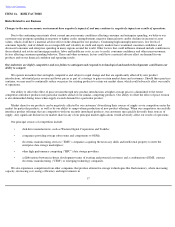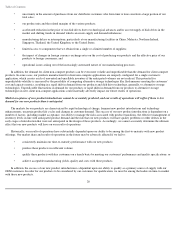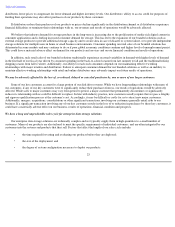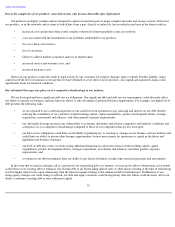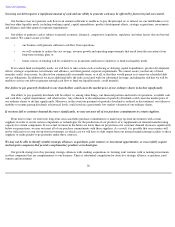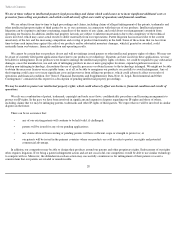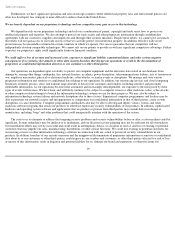Seagate 2013 Annual Report Download - page 27
Download and view the complete annual report
Please find page 27 of the 2013 Seagate annual report below. You can navigate through the pages in the report by either clicking on the pages listed below, or by using the keyword search tool below to find specific information within the annual report.
Table of Contents
As a result, our sales cycle for enterprise data storage solutions is often in excess of one year, and the length of our sales cycle is frequently
unpredictable. In addition, the emerging and evolving nature of the market for the products that we sell may lead prospective customers to
postpone their purchasing decisions. We invest resources and incur costs during this cycle that may not be recovered if we do not successfully
conclude sales. These factors lead to difficulty in matching revenues with expenses, and to increased expenditures which together may adversely
impact our results of operations.
If we do not control our operating expenses, we will not be able to compete effectively in our industry.
We continually seek to make our cost structure and business processes more efficient. We are focused on increasing workforce flexibility
and scalability, and improving overall competitiveness by leveraging our global capabilities, as well as external talent and skills, worldwide. Our
strategy involves, to a substantial degree, increasing revenue and product volume while at the same time controlling operating expenses. If we do
not control our operating expenses, our ability to compete in the marketplace may be impaired. In the past, activities to reduce operating costs
have included closures and transfers of facilities, significant personnel reductions and efforts to increase automation. The reduction of personnel
and closure of facilities may adversely affect our ability to manufacture our products in required volumes to meet customer demand and may
result in other disruptions that affect our products and customer service. Our efforts to make our operations more efficient may result in
restructuring and other charges.
Increases in the areal density of disk drives may outpace customers' demand for storage capacity.
The rate of increase in areal density, or storage capacity per square inch on a disk, may be greater than the increase in our customers'
demand for aggregate storage capacity, particularly in certain market applications like client compute. As a result, our customers' storage
capacity needs may be satisfied with lower priced, low capacity disk drives. These factors could decrease our sales, especially when combined
with continued price erosion, which could adversely affect our results of operations.
If we do not develop products in time to keep pace with technological changes, our results of operations will be adversely affected.
Our customers have demanded new generations of disk drive products as advances in computer hardware and software have created the
need for improved storage products, with features such as increased storage capacity, improved performance and reliability and lower cost. We,
and our competitors, have developed improved products, and we will need to continue to do so in the future. Such product development requires
significant investments in research and development. We cannot assure you that we will be able to successfully complete the design or
introduction of new products in a timely manner, that we will be able to manufacture new products in sufficient volumes with acceptable
manufacturing yields, that we will be able to successfully market these new products or that these products will perform to specifications on a
long-term basis. In addition, the impact of slowing areal density growth may adversely impact our ability to be successful.
When we develop new products with higher capacity and more advanced technology, our results of operations may decline because the
increased difficulty and complexity associated with producing these products increases the likelihood of reliability, quality or operability
problems. If our products suffer increases in failures, are of low quality or are not reliable, customers may reduce their purchases of our products
and our manufacturing rework and scrap costs and service and warranty costs may increase. In addition, a decline in the reliability of our
products may make us less competitive as compared with other disk drive manufacturers or competing technologies.
24





